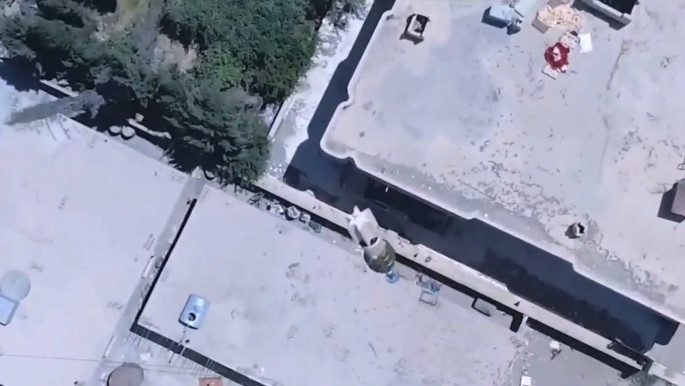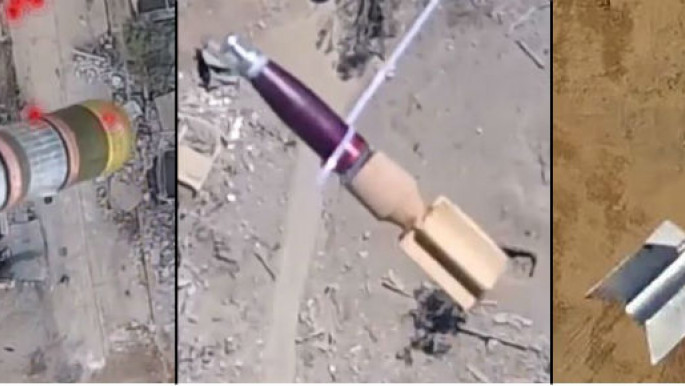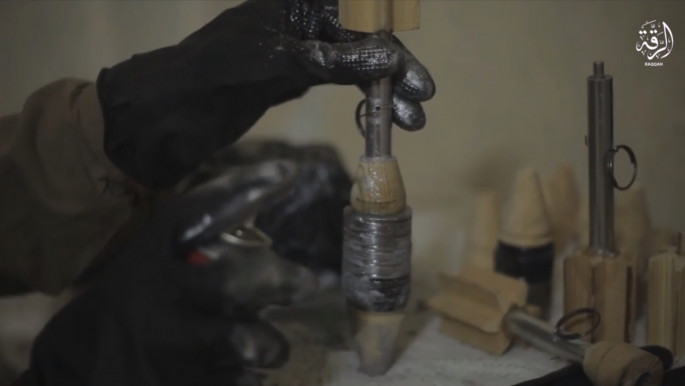Killer toys: How the Islamic State group revolutionised warfare
Its use of high quality, well-produced propaganda, the extensive use of social media as a recruitment and information warfare tool, and its singular brutality has set IS apart from the majority of other sub-state armed groups.
However, in the field of improvised and commercial off-the-shelf drone use, IS has been an integral part of a revolution, and one that is likely to have profound effects upon the conduct of conflict by all parties.
Over the course of 2017, IS published media related to more than 200 attacks carried out by its drones, which I captured in this database.
This media reveals a large amount of information we can use to examine the conduct of their air campaign across Iraq and Syria.
Their media ranged from images to videos, and included not only the strikes themselves, but also glimpses of a weapons programme that effectively created a unique airforce comprised entirely of drones. This article will draw out some of the lessons we have learned from a year of Islamic State drone strikes.
Firstly, it must be noted that this is information taken entirely from IS sources. This means every attack these images and videos depicts is one that IS wants to be shown.
They will not have included the attacks that failed, or the bombs that did not hit their target. Even accommodating for this, it is evident that these drones can be impressively accurate.
Several of the attacks show bombs dropping into the open hatches of vehicles, and at least one strike in Raqqa during October landed immediately next to a vehicle after being dropped from a height of about 1,000 feet.
Although IS has depicted these bomblets being dropped from plane-like drones, it seems unlikely that this technique has ever been used in combat. Trying to hit a target by dropping bomblets from a moving drone would be a difficult exercise, and require a high degree of training and skill.
IS does not appear to have released any images or videos that shows this actually happening. Instead, analysis of the media associated with these strikes indicate that all these bomblets were dropped by rotary-wing drones that could hover over their target, which helps to explain their accuracy.
 |
| This image, taken from a four-second clip (see video below) purportedly shot from an IS drone, shows how accurate an IS drone strike can be, dropping this bomblet to destroy a car parked mostly under cover. The bomblet falls between the buildings and destroys the vehicle |
The accuracy with which these bomblets can be dropped magnifies their apparent lack of firepower. Many examples of IS drones that have been shot down only have room for a single bomblet.
In a firefight, a single 40mm grenade would not make much difference, but when it can be dropped in exactly the right place at the right time, a single small munition can potentially have an explosive strategic effect.
IS demonstrated this in October 2017 when it attacked a Syrian government ammunition depot in Deir az-Zour [see the main image at the top of this article]. Using two small drones and two small bomblets, they destroyed a huge amount of ammunition belonging to an already cash-strapped army.
At a tactical level these drones can dislocate and suppress their targets to great effect. By hovering over a group of fighters within earshot, these drones can create the fear of death or injury just by their presence alone.
It is notable that as soon as troops hear the buzz of drones, they run for cover, scattering in all directions. These drones are also accurate enough to hit high value targets such as command groups, combat vehicles and communication masts.
This effectiveness makes them a unique and powerful addition to the armoury of insurgent groups, allowing them to conduct consistently accurate strikes on important point targets, a capability which, for the most part, sub-state actors previously lacked.
These images also showcase the Islamic State group's industrial base and nascent weapon manufacturing capability. The munitions they used in these attacks range from bomblets which appear to have had their fins made out of tin cans, to mass-manufactured munitions produced in dedicated armaments factories.
Each design of bomblet has a story of its own and can indicate when and where it was created. Mosul, Deir az-Zour and Raqqa appear to have been the three main centres of IS drone activity, and bomblets dropped in each location have identifiable features.
Mosul saw heavy use of 40mm grenades and custom-made bomblets, units in Raqqa used a wooden tail carved into a unique star shape, while Deir az-Zour saw the use of "pineapple"-type bomblets and basic metal fins.
 |
| Examples of different home-made bomblets found in Mosul (left), Raqqa (centre) and Deir az-Zour (right). The red crosshairs added to the image are a hallmark of IS propaganda videos for identifying munitions and targets |
Considering the standardisation that is evident in some of these bombs, it's not surprising that there appears to have been a certain amount of mass production. Mosul also saw the use of a mass-produced bomblet which could be used as a drone bomb, thrown by hand, or fired from a modified rifle.
It used a standardised point-detonating fuze which was also utilised in a wide variety of munitions. In Raqqa it appears IS may have used smaller workshops to produce these bomblets, judging by a video that was released in October.
The bomblets in Raqqa were generally distinguished by a wooden, star-shaped tail which was attached to a variety of warheads. This range of manufacturing methods seems to have led to the manufacture of bomblets that appear to range in design and quality.
Although this range could be related to local preference, it seems likely that the supply chains for these regions would also have a significant effect upon their construction.
While IS units in Mosul, a large industrialised city, used a standardised and apparently multi-purpose bomblet, strikes in other regions showed bombs that appeared to be of questionable quality.
 |
| The bomb-making process [Still image taken from IS propaganda video] |
With their versatility and relatively low logistical footprint, off-the-shelf and improvised drones have not only been used by IS to drop small bomblets - they have also been employed to conduct reconnaissance, adjust artillery fire and co-ordinate troops in battle.
This is another capability that has mostly been limited to state actors in recent years, although drones have previously been used in similar roles by Hamas, FARC, Lashkar-e-Taiba and of course Hizballah, although on a much smaller scale.
IS has successfully integrated their drones into other types of operations, most notably within their Suicide Vehicle-Born Improvised Explosive Device (SVBIED) programme. In the battle for Mosul, IS deployed hundreds of suicide car bombs, many of which were caught on camera by drones.
These videos formed a core part of IS propaganda, demonstrating their ability to release destruction on a scale comparable to airstrikes.
However, it appears that IS did not simply use drones to record the videos: they also used live imagery from the drones to direct the drivers to their targets. Considering that many of these SVBIEDs were armoured, leaving a small slit for the driver to see through, the situational awareness provided by drones would have been a vital part in guiding a suicide car bomber to their target.
An excellent example of this kind of combined arms use of drones was captured by IS propaganda from Mosul. An IS drone observes a small group of Iraqi Security Forces before dropping a bomblet and appearing to wound several of soldiers.
The drone then gains altitude to show the whole scene, including an ISF vehicle reversing from its position, presumably to aid the wounded.
Seconds later, an SVBIED, using the confusion the drone has created, hurtles towards the Iraqi military vehicle and detonates while the troops inside are distracted. This brutally effective attack shows how drones can be combined with other weapons to magnify their effectiveness, turning a heavily armoured car bomb into a guided missile.
| |
| Video: Two attacks - the first demonstrating the accuracy of drone-released bomblet, the second, a depiction of a drone strike used in tandem with a suicide car bomber. Note how the drone-dropped bomb is used as a distraction, drawing in a military vehicle, and allowing the suicide bomber to get close to the scene before detonating [Clips taken from IS propaganda video, shown here for analysis purposes] |
The use of off-the-shelf and improvised drones by IS is the very beginning of a revolution that will likely change the face of conflict.
Both sub-state groups and conventional militaries have become aware that this cheap and relatively simple capability can have a significant effect on the battlefield.
Indeed the fact that this effect is being delivered by what are essentially toys armed with individual grenade-sized bombs makes this capability even more alarming.
Rather than see these drones in the context of the firepower they can deliver, or their roots as toys, they should be measured by the effect they have.
As IS has shown, the ability to deliver a small bomb to precisely the right place at the right time can be devastating.
When combined with other weapons such as suicide car bombers, they can be a force multiplier, providing capabilities to small groups that, until recently, were mostly limited to state-level actors.
It remains to be seen if and how this kind of weapon can be applied to domestic terrorism. However, the inability for countries to defend their own critical infrastructure such as airports and military installations from hobby drones indicates this is a vulnerability that has yet to be fully exploited.
Nick Waters is a former infantry officer and digital media analyst, specialising in drone warfare. Follow him on Twitter: @N_Waters89





 Follow the Middle East's top stories in English at The New Arab on Google News
Follow the Middle East's top stories in English at The New Arab on Google News


